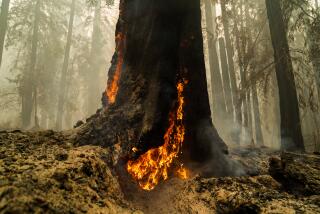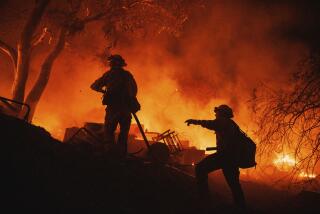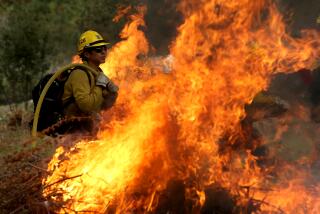The future of fire, and hotshots
Along with barked orders and the whine of chain saws, the clank of steel on rock was certainly one of the sounds that rose from a hillside near Yarnell, Ariz., last month as clouds of superheated smoke roiled the sky, portending a tragedy.
One morning a dozen years ago, I heard an opportunity in that sound.
“Hold up a second,” I said.
My son Rob, 12 at the time, gave me a withering look and kept stomping on the pedals of his mountain bike. It was pushing 90 degrees in the Southern California foothills that spill from forested mountains into San Bernardino, and Rob had no interest in losing our plodding upward momentum.
“Seriously,” I said.
We plopped our bikes on the fire road’s berm and advanced toward the sound through a gap in the head-high wall of chaparral. Spotting a cluster of young men deep in the thicket, Rob practically quivered with the panic of an adolescent male whose father was once again about to prove himself — and his son by association — clueless, dorky, lame.
The sweat-drenched men lowered their pulaskis and brush hooks and eyed us in our wildly colored jerseys and spandex bike shorts.
“Del Rosa?” I asked.
One of the older guys, perhaps 25, probably a squad leader, stepped forward. We were miles past a locked gate, standing in a landscape so spare that only a few acquire a taste for it. The implied challenge in the squad leader’s minimalist nod was entirely called for.
“I was on this crew years ago,” I said.
That was all it took. In a single ragged gesture, the crew members, some in bright yellow fire-retardant shirts, others wearing T-shirts emblazoned with “Del Rosa Interregional Hot Shots,” put aside their training and offered a salute of faint smiles, uplifted chins and outstretched hands.
For a few minutes, we chatted about the mundane subjects that occupy hour after hour in fire camp or on mop-up duty: improvements in the tools of the trade, what brand of boots was currently in favor, how the season was shaping up for overtime and hazardous-duty pay.
Like all wildland firefighters, we also swapped stories. I have dozens, but the one I probably told that morning took place early in my rookie season when a fire near Mt. San Jacinto blew up on us and I ignored a squad boss’ shouted orders to retreat uphill along our designated escape route.
Exhausted and seeing what looked like a course of less resistance, I sprinted downhill. Within seconds, buckthorn and scrub oak entangled my gear belt and aluminum fire shelter. Struggling madly, I watched windblown embers ignite a chaos of spot fires on the hillside below. I still don’t know how I finally freed myself and staggered up to the safety zone — just moments before the brush that had trapped me exploded into spirals of roaring flame.
We could have traded tales for hours on that heat-blasted ridge. When Rob and I took off, heading deeper into the hills, I knew a seed had been planted.
My own inspiration to fight fires came not far from where Rob and I were riding, when I was 9 or 10 and a brush fire charged out of those same San Bernardino mountains, threatening my family’s home. The next day a friend and I picked up shovels and hiked into the smoldering hills to emulate the young men we’d watched save our neighborhood.
On our bike ride Rob too glimpsed in the hotshot crew a rare camaraderie forged by fire and confrontation with calculated risks. I suspect that he recognized that day a personal escape route, a way to vent the restless need to test oneself that often inflames the young. I wouldn’t have discouraged him.
Yet when I heard that wildfire had overrun and killed 19 Arizona hotshots, my primary emotion was relief that Rob, now 23, quenches his thirst for adventure by river rafting and roughing it across China. I shuddered with sympathy for the parents who had received the call, and I knew that for the firefighters, at least one thing that has been offered up as consolation is rooted in truth: They did die doing what they loved, and part of what they loved was the danger.
I’ve come to doubt, however, another often-voiced cliche: “They understood the risks.”
A federal study released this year joins a growing body of literature connecting the frequency and intensity of wildfires worldwide to the global climate disruption that we have created by living lives dependent on the burning of fossil fuels. The Granite Mountain Hotshots may well have known about this connection. I’m confident that neither hotshots nor anyone else yet has a clue what it all means for the future of computer-modeled firefighting strategy, let alone about the multitude of life-or-death judgment calls firefighters make in any given wildfire.
Two years after that mountain bike encounter with the Del Rosa hotshot crew, my brother Tim called me from our childhood home to say: “We’ve been ordered to evacuate.”
We’d been through this before, and my wife, Pam, and I were calm as we into San Bernardino. This, however, was a harbinger, like no other fire I’d ever seen, as a child living in what wonks now call the “urban-wildland interface,” or in the five seasons I paid my way through college working for the U.S. Forest Service.
For an hour or two, we stood in a distant wash, watching the firestorm cascade down from the mountains and into the city like a 5,000-foot-high wall of lava. Tim and I sneaked through the police lines and crept into a landscape Dante might have envisioned.
Fire engines slipped through the darkness, lights flashing helplessly. Several times the wind shifted and we turned and ran. That and the other wildfires of October 2003 claimed 26 lives and destroyed 3,361 structures across Southern California, our home included.
Almost a decade later, San Bernardino has not fully recovered from that $1-billion conflagration — not economically, sociologically or emotionally. As fires burn this summer, and as the tragedy in Arizona spurs commentary about more wildfires made more intense, we as Westerners have a lot to think about.
Here’s one relatively small thing I think about with sadness: The almost supernatural threat of these new conflagrations may soon relegate to history the character-tempering crucible of hotshot firefighting.
Bob Sipchen shared in two Pulitzer Prizes in his years as staff writer and editor at the Los Angeles Times. He is now editor in chief of Sierra magazine and communications director for the Sierra Club.






